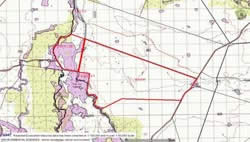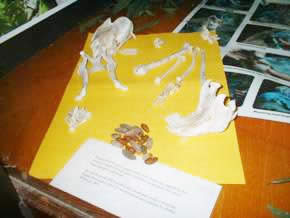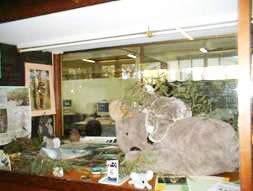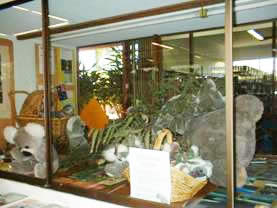
CENTRAL
QUEENSLAND KOALA VOLUNTEERS
SPRING
NEWSLETTER Continued
On Sunday, 29 August, Shirley and I headed out to Monto in the hope that we would find koalas or evidence of them on ‘Goondicum’, a property in that area. With Shirley’s mud map we managed to find our way and arrived at 4.30pm. We were met by several friendly dogs and the property owner, Roseanne, a delightful lady and her son, Robbie, who made us so welcome. After a wonderful meal of red emperor, followed by mango, peaches and ice-cream plus a little wine, I was ready for bed and slept like a babe.
In the morning we set off to an area near the mine site where a big gum had fresh scratches but no sign of droppings though we scoured the canopy area. We spent the morning walking along both sides of one gully and hillside until we reached the major creek and boundary, approximately 4 kms. We saw no signs of koala activity and only a small number of trees had scratches – no scats at all.
We had our lunch sitting on the hillside and decided to go back and try another area. In the afternoon, we walked with Robbie and a relative to a creekline in another direction. We showed them what to look for – (I had taken a few droppings that Mary had used at the Library). Shirley and I walked back along the creek but saw no evidence of koalas, though I did see the markings of gliders on a few trees. That evening we had another great meal and champagne (you would have thought we had found koalas to earn this).
On the next day, we walked along another creek where a few old droppings were found at the base of a mahogany tree but no scratches were seen on any trees in this area. The terrain was rather hilly with gullies between. The grass, mostly kangaroo and spear, was long and dry. The trees were: blue-gum (tereticornis), iron bark (creba, melanophlioa & broad leafed), lemon scented (citridora) on hills, spotted gum (maculata), dawson gum (cambageana), mahogany (lopostemon?), casuarinas and ti-trees in the creek beds. The timber was open with no under-story.
The trees on the hill were severely stressed from drought with very little ‘old growth’. As the gums had only recently lost their bark, it was impossible to discern scratches. There had been a lot of leaf fall so there was no sign of droppings, either. We felt we did a very thorough search for any evidence of koalas but found nothing to indicate their presence at this period of time.
It was most disappointing because Roseanne showed us photos of koalas they had seen previously. We had some pellets to show her so she will now know what to look for as well as the scratches on trees so we may hear from them in the future.
It was a most enjoyable couple of days spent with such very nice people. It started to rain as we were leaving and rained all the way to Westward.
Carmen Drake
The Scientific Advisory Committee of the Koala Research Centre of Central Queensland met in Rockhampton in early September. Carmen Drake represented the CQ Koala Volunteers at that meeting. The advisory committee included Associate Professor Steve McKillup (Chair, CQU), Dr Frank Carrick (University of Queensland), Dr Alan Horsup (Queensland Parks and Wildlife Service), Associate Professor Kerry Walsh (CQU) and Ruth McKillup (Secretary). The committee reviewed the research program of the Koala Research Centre and provided advice on the strategic direction and quality of the research pursued. The Scientific Advisory Committee passed a motion of appreciation of the CQ Koala Volunteers for supporting koala postgraduate studies at CQU and is writing a formal letter of thanks to that effect.
Alistair Melzer
COMETSIDE FIELD TRIP
*Late September/Early October 2004
*Overnight trip
*Approx 3.5 hours drive
*4WD Preferred
Accompany John McCabe and Karmen Williamson, (extension officers with EPA Rockhampton and Emerald) to visit the Stuart family who are contemplating a wildlife reserve on their 1 000 hectare coolabah flats/blue gum riparian remnant alongside the Comet River and Clematis Creek – a frontage of several kilometres in total, within a cleared northern region of Arcadia. Koalas have been sighted there in the past years.
Tasks:
- Assess habitat
- Look for clues
- Collect samples of scats, photo records, and stories
- Share survey techniques and spotting abilities
- Meet and greet locals, share our philosophies and knowledge
Contacts:
Mary McCabe 4927 1051 or
John McCabe c/o EPA Rockhampton
Karmen Williamson c/o EPA Emerald

EARTHWATCH FELLOWSHIP OPPORTUNITIES
Earthwatch fellowships available to members of environmental groups
Members of local environmental groups have the opportunity to join an Earthwatch research project free of charge under Earthwatch’s new Communities for Conservation program. The program is designed to involve the Australian community in important conservation research. Seven spaces on selected Earthwatch projects will be made available to people already active in their local community’s environmental initiatives.
Fellowships include:
• Expedition costs, including food and accommodation
• $400.00 travel allowance or $400.00 towards a second person’s expedition costs
Successful applicants will need to have a passion for the environment and a willingness to share their experience with their community group.
Communities for Conservation fellows will join either Dr Freudenberger from CSIRO Sustainable Ecosystems to investigate the return of bird communities to re-established tree plots on agricultural land in Holbrook, NSW; or assist Dr David Paton from the University of Adelaide monitor changes to the fragile ecosystem of the Coorong wetlands and assess the impact local agriculture is having on food availability for the millions of migratory waterbirds that use these lagoons every year.
If you have any queries, please contact Emily Boldiston at Earthwatch on (03) 9682 6828 or on the web at EARTHWATCH
Applications close Friday 15 November 2004.
**Please share this information with people in your local community; your local environment group or anyone else you think might be interested. **
A small press release is also available to anyone who has a newsletter and it is available on request.
Alistair Melzer
Koala Volunteers to fill the role of Field Mentors on Earthwatch Field Trips.
Field mentors will be required to assist the research team with the logistics and field tasks during the trip while tutoring international visitors about the basic Australian bush craft. Most importantly, however, you will be required to have FUN and ENJOY the trip as part of the team.
You will need to get yourself to and from either Rockhampton or Mackay at your own expense, with all remaining trip costs covered by Earthwatch and the Koala Research Centre.
Trip dates are as follows:
October 2004 - Wednesday 13th to Monday 25th
January 2005 - Thursday 27th to
Tuesday 8th February
Dates to be confirmed:
May 2005 - Friday 6th to Wednesday 18th
July 2005 - Wednesday 20th to
Monday 1st August
October 2005 - Friday 14th to
Wednesday 26th
If you are available and would like to join one of these teams or if you would like any more information, please call or e-mail Gail Tucker, 07 4930 9625 or g.tucker@cqu.edu.au.
Reminder
Calendars and postcards are now available from Gail or from Outback Books, Ground floor, Old Government Building, cnr East & Fitzroy Streets. Great Christmas presents!
ART EXHIBITION
My Art Exhibition – ‘Red Dust Settles’ – was well attended and commission from sales enough to profit Koala Volunteers by $xx. The raffle of a Linocut netted another $xxx so a total of $xxx was given to the Volunteers. The raffle was won by Mary McCabe.

Mary, Dawn and I set up a display in the North Rockhampton Library in August. We hope the display gave viewers a better understanding of how CQKV help in the research into our Central Queensland Koalas.

